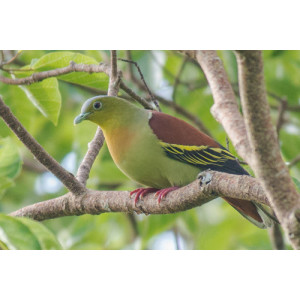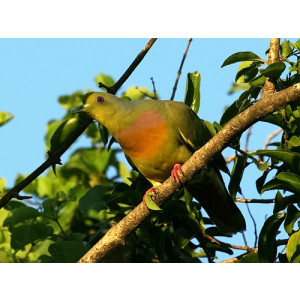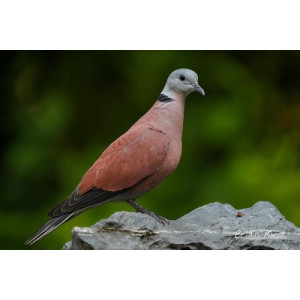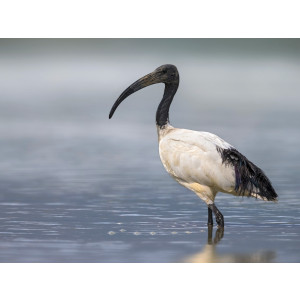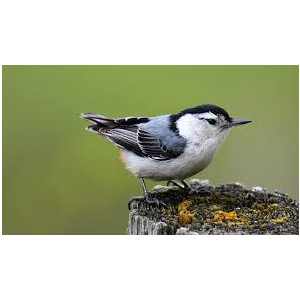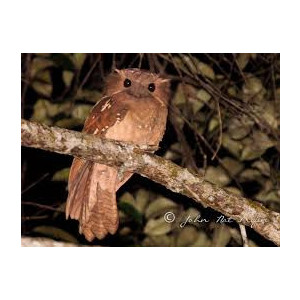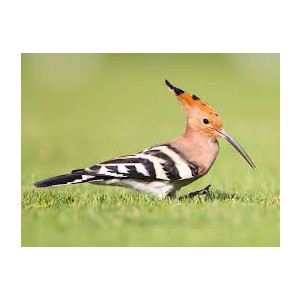Eastern Spotted Dove Did you see this animal?
Scientific Name : Spilopelia chinensis
Family : Columbidae
Order : Columbiformes
Class : Aves
Phylum : Chordata
Habitat : Villages
Description : This dove is long tailed buff brown with a white-spotted black collar patch on the back and sides of the neck, pale pink breast. The tail tips are white and the wing coverts have light buff spots. It is diurnal and feeds mainly on seeds of grasses, shrubs, weeds and bamboos, cereals and green shoots. Spotted doves are typically seen in pairs or small groups as they search for food on the ground, feeding on grass seeds, grains, fallen fruits, and various plant seeds. Although their diet primarily consists of plant matter, they occasionally consume insects, including winged termites. Their flight is quick, characterized by regular wing beats and occasional wing flicks. During courtship displays, they take off at a steep angle with a loud wing clap and glide down slowly with their tails spread out.
Breeding seasons vary, with warmer regions having more spread-out breeding periods, while temperate regions tend to see breeding during the summer. In Hawaii, spotted doves breed throughout the year, along with three other introduced dove species. Male doves engage in cooing, bowing, and aerial displays as part of courtship behavior. In southern Australia, breeding mainly occurs from September to January, while in the northern regions, it occurs during autumn. Nests, typically flimsy cups made of twigs, are constructed in low vegetation, on the ground, or even on buildings and other structures. Two whitish eggs are laid, and both parents participate in nest-building, incubation, and feeding of the young. Eggs hatch after approximately 13 days, and the chicks fledge after about two weeks. Multiple broods may be raised during a breeding season.
The vocalizations of spotted doves include soft cooing sounds, often with variations in the number of terminal coos depending on the regional population. The species has been expanding its range in many parts of the world. Population levels can fluctuate rapidly, sometimes within a span of five years. In the Philippines, they may outcompete the Streptopelia dusumieri species. Their habit of flying into the air when disturbed poses a hazard on airfields, as they can collide with aircraft and cause damage.
Breeding seasons vary, with warmer regions having more spread-out breeding periods, while temperate regions tend to see breeding during the summer. In Hawaii, spotted doves breed throughout the year, along with three other introduced dove species. Male doves engage in cooing, bowing, and aerial displays as part of courtship behavior. In southern Australia, breeding mainly occurs from September to January, while in the northern regions, it occurs during autumn. Nests, typically flimsy cups made of twigs, are constructed in low vegetation, on the ground, or even on buildings and other structures. Two whitish eggs are laid, and both parents participate in nest-building, incubation, and feeding of the young. Eggs hatch after approximately 13 days, and the chicks fledge after about two weeks. Multiple broods may be raised during a breeding season.
The vocalizations of spotted doves include soft cooing sounds, often with variations in the number of terminal coos depending on the regional population. The species has been expanding its range in many parts of the world. Population levels can fluctuate rapidly, sometimes within a span of five years. In the Philippines, they may outcompete the Streptopelia dusumieri species. Their habit of flying into the air when disturbed poses a hazard on airfields, as they can collide with aircraft and cause damage.
Distribution in Bangladesh
References:
description written by:Fatema-Tuz-Zohora,Department of Zoology, Jagannath University,Dhaka;information source:iucnredlist.org, www.en.wikipedia; photo credit: makarandsaraf(www.inaturalist.org/people/ makarandsaraf),photo shared from iNaturalist, photo copyright reserved according to iNaturalist rules;;taxonomic checklist:P. M. Thompson and S. U. Chowdhury (2020). A checklist of birds of Bangladesh.Birds Bangladesh;bird song owner:James Lambert(www.xeno-canto.org/James Lambert), bird sound copyright reserved according to www.xeno-canto.org rules; more information, please contact us.
description written by:Fatema-Tuz-Zohora,Department of Zoology, Jagannath University,Dhaka;information source:iucnredlist.org, www.en.wikipedia; photo credit: makarandsaraf(www.inaturalist.org/people/ makarandsaraf),photo shared from iNaturalist, photo copyright reserved according to iNaturalist rules;;taxonomic checklist:P. M. Thompson and S. U. Chowdhury (2020). A checklist of birds of Bangladesh.Birds Bangladesh;bird song owner:James Lambert(www.xeno-canto.org/James Lambert), bird sound copyright reserved according to www.xeno-canto.org rules; more information, please contact us.




